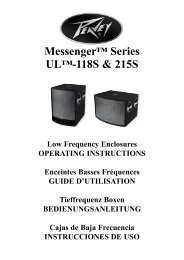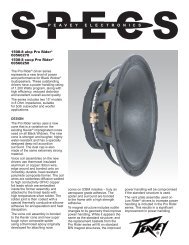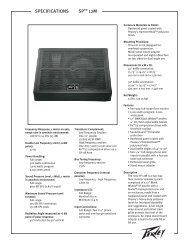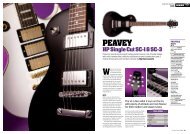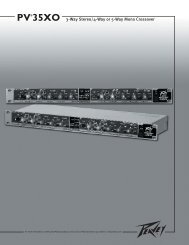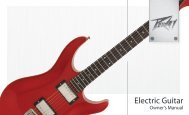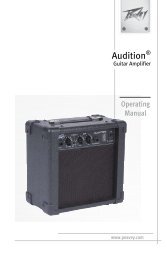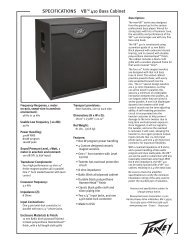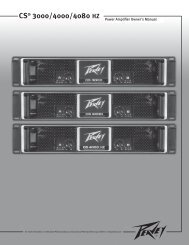You also want an ePaper? Increase the reach of your titles
YUMPU automatically turns print PDFs into web optimized ePapers that Google loves.
vent construction. The pipe should<br />
be dadoed tightly into the back of the<br />
baffle and glued firmly in place with<br />
high quality epoxy or high strength,<br />
industrial grade hot glue. Rough up<br />
the outside of the pipe to improve the<br />
glue bond.<br />
Be sure to account for the<br />
displacement of the vent, bracing,<br />
horn (if used) and woofer or your<br />
enclosure before building it or it will be<br />
smaller than its intended volume. This<br />
can reduce bass output and mis-tune<br />
the enclosure.<br />
Line the inside of the enclosure<br />
with polyester fiber batting such as<br />
quilt stuffing. The batting material<br />
should conform to California bedding<br />
fire codes. Attach the batting with<br />
spray adhesive or staples and keep<br />
material away from the end of the<br />
vent tube where it can be pulled in by<br />
air flow.<br />
When building a bandpass enclosure,<br />
design a panel or door to be<br />
removable for access to the woofer.<br />
Use foam weather-strips to seal the<br />
panel along with enough screws and<br />
bracing to prevent leaks and buzzes.<br />
Fill the sealed volume loosely with<br />
polyester fiber, but leave the vented<br />
volume empty. Place the magnet<br />
of the woofer in the vented side for<br />
improved cooling.<br />
Handles, protective corners, cabinet<br />
covering, grille materials and<br />
crossovers are available through<br />
<strong>Peavey</strong> Accessories.<br />
<strong>Peavey</strong> does not supply hardware<br />
required for the manufacturing of<br />
flying systems, and recommends that<br />
builders should not suspend or fly<br />
any enclosure not certified for such<br />
applications.<br />
These instructions are a general<br />
guideline for design. <strong>Pro</strong>per<br />
construction techniques, good<br />
planning and common sense will<br />
result in a reliable, high quality, high<br />
performance system.<br />
<strong>Peavey</strong> in on way accepts liability for<br />
any damage, accidents or injury that<br />
may result from construction or use of<br />
enclosure using this information.<br />
PARAMETERS<br />
Thiele-Small parameters for Sheffield ®<br />
<strong>Pro</strong> 1200+ and Sheffield <strong>Pro</strong> 1500+<br />
drivers follow. This data is for use<br />
in designing enclosures. Numerous<br />
software packages are available that<br />
use this data to simulate the response<br />
of the driver and enclosure together<br />
for optimum performance in any<br />
application.<br />
PARAMETER DEFINITIONS<br />
Znom: The nominal impedance of the driver in<br />
Ohms.<br />
Revc: DC resistance of the driver in ohms, also<br />
known as Re.<br />
Sd: The functional radiating surface area of the<br />
cone assembly in meters 2.<br />
BL: Efficiency of the voice coil and magnet<br />
system in Tesla meters.<br />
Fo: Free air resonance. Also known as Fs.<br />
Vas: Volume of air having the same compliance<br />
(springiness) as the driver’s suspension.<br />
Cms: Restorative force of the driver’s<br />
suspension in micrometers/Newton.<br />
Mms: The total mass of the moving parts of the<br />
loudspeaker, including the air load, in grams.<br />
Qms: Resonance characteristics of the<br />
mechanical factors of the loudspeaker.<br />
Qes: Resonance characteristics of electrical<br />
factors of the loudspeaker.<br />
Qts: Resonance characteristics of the electrical<br />
and mechanical factors combined together.<br />
Xmax: Distance the cone can move in one<br />
direction before the coil begins to leave the<br />
magnetic gap.<br />
Le: Inductance of the voice coil in millihenries.<br />
SPL: Typical sound pressure level at 1 watt, 1<br />
meter.<br />
no: Electrical to acoustical conversion efficiency<br />
in percent.<br />
Vd: Air displacement of the driver from negative<br />
Xmax to positive Xmax.<br />
Pmax: Maximum continuous program power in<br />
watts.<br />
Disp: Volume displaced by the driver inside the<br />
cabinet when mounted on its rear flange




